Food Preparation Business Plan
What’s For Dinner? is an innovative business that helps people enjoy home cooked meals with their families. Customers come to our Plano, TX location and prepare 12 pre-selected meals in a fun party atmosphere. In just two hours, they can stock up their freezer with a month’s worth of meals.
By focusing on our unique selling point (no direct competitors in the Dallas/Ft. Worth area), our customers, and their needs, What’s For Dinner? aims to exceed $1.3M in sales within three years.
What’s For Dinner? is jointly owned by Alan and Kim Kirby as an S Corporation. They both have 15 years of experience in the food service and entertainment industries. Alan is a party planner, while Kim is a personal chef. With two teenaged children, they understand the challenges of providing healthy, affordable, and quick meals for a whole family. Alan’s connections with local social and community groups, combined with Kim’s relationships with food distributors, specialty grocers, and high-end clients, will contribute to high sales from the first year.
What’s For Dinner offers several advantages to its target market:
- Relatively inexpensive meal preparation: ~$15 for a four-person meal.
- Fun, social atmosphere.
- Convenient: eat prepared meals at home, anytime.
- Saves time: no shopping, prep, or clean up.
- Special menus and transportation assistance for seniors.
- No more pondering “What’s For Dinner?”
This plan has two objectives: to secure funding of $259,708 and to establish the company’s vision, philosophy, and strategy for future success.
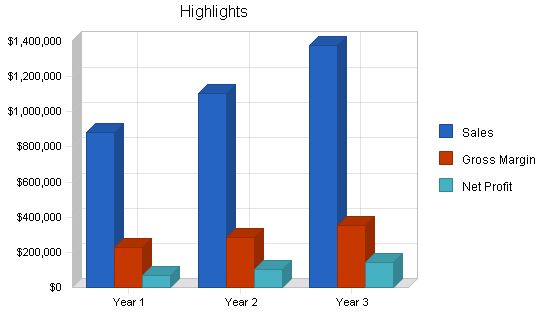
What’s For Dinner? is a specialized business providing the opportunity to prepare health conscious meals that can be frozen and consumed later. The purpose is to optimize meal preparation time and encourage health conscious behavior.
What’s For Dinner? aims to create a unique and distinctive service that combines a party-like atmosphere with professional food preparation. This will attract a growing repeat customer base, giving families and busy professionals more time.
The goal is to be a self-sustaining enterprise within 3 years, expand the menu offerings within 3 months, and expand the locations within 4 years. The company plans to employ 4 individuals full-time within 3 years and achieve a net profit of $100,000 by the second year.
In short, What’s For Dinner? relieves customers’ daily stresses of meal preparation by providing a great menu choice.
The keys to success in this business are high customer satisfaction, effective marketing, great product quality and variety, smart finances, seasonal menus, exceeding customer expectations, and an efficient website for registration and payment.
The objectives for What’s For Dinner? in the first three years include exceeding customers’ expectations, increasing the number of clients served by 25% per year, developing a profitable start-up business, achieving an after-tax net profit of $134K by year three, and achieving a net income of over 10% of sales by the third year.
What’s For Dinner? is a unique business where customers come to the Plano, TX location, prepare pre-chosen meals, and take them home to freeze and cook later. All planning, shopping, food preparation, and containers are provided. Meals are prepared in a party-like atmosphere where customers have separate workstations to enjoy with friends.
The scheduling aspect includes a walk-up scheduling procedure, a phone messaging service, and an interactive website for scheduling and secure online payment.
The start-up expenses include rent, utilities, insurance, sales and marketing materials, website development, office and kitchen supplies, and leasehold improvements.
The required start-up assets of $50,000 include kitchen equipment, prep tables, cooking utensils, various kitchen utensils, computer, and small business software.
The purpose of this business plan is to secure funding of $259,708, appearing as a long-term liability on the Start-up Funding table.
The start-up assumptions are summarized in the following chart and table.
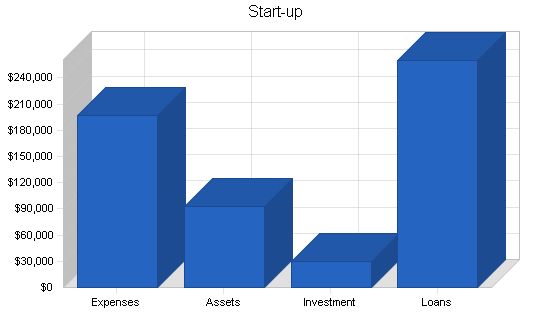
Start-up Funding:
– Start-up Expenses to Fund: $196,708
– Start-up Assets to Fund: $93,000
– Total Funding Required: $289,708
Assets:
– Non-cash Assets from Start-up: $59,000
– Cash Requirements from Start-up: $34,000
– Additional Cash Raised: $0
– Cash Balance on Starting Date: $34,000
– Total Assets: $93,000
Liabilities and Capital:
– Liabilities:
– Current Borrowing: $0
– Long-term Liabilities: $259,708
– Accounts Payable (Outstanding Bills): $0
– Other Current Liabilities (interest-free): $0
– Total Liabilities: $259,708
– Capital:
– Planned Investment:
– Alan Kirby: $15,000
– Kim Kirby: $15,000
– Other: $0
– Additional Investment Requirement: $0
– Total Planned Investment: $30,000
– Loss at Start-up (Start-up Expenses): ($196,708)
– Total Capital: ($166,708)
– Total Capital and Liabilities: $93,000
– Total Funding: $289,708
Start-up Requirements:
– Start-up Expenses:
– Legal: $1,500
– Stationery etc.: $400
– Office Supplies: $500
– Kitchen Supplies: $1,000
– Janitorial Supplies: $400
– Insurance: $719
– Rent: $5,182
– Utilities: $1,085
– Sales and Marketing: $2,800
– Website Development: $4,000
– Leasehold Improvements: $140,000
– Licenses/Permits: $422
– Construction Fees / Permits: $35,000
– Outdoor Sign: $3,500
– Miscellaneous: $200
– Total Start-up Expenses: $196,708
– Start-up Assets:
– Cash Required: $34,000
– Start-up Inventory: $9,000
– Other Current Assets: $8,000
– Long-term Assets: $42,000
– Total Assets: $93,000
– Total Requirements: $289,708
Company Ownership:
What’s For Dinner? is a privately held Sub Chapter S-corporation. This allows for the protection provided by the corporate legal structure combined with Generally Accepted Accounting Principles that make financial sense to the company’s owners, Alan and Kim Kirby. Each owns a 50% stake in the company. What’s For Dinner? operates under the jurisdiction of the State of Texas and the United States of America.
Services:
What’s For Dinner? will provide customers with twelve home cooked meals that they will freeze until ready to serve. These meals will be chosen from a set weekly menu and prepared at our location. All planning, shopping, food preparation, recipe directions, and containers will be provided to make it easy for customers to enjoy their time at our establishment.
Customers will prepare their meals in a fun, party-like atmosphere where they can relax, meet new friends, or spend time with old friends while preparing dinners for their families. Our customers will benefit from:
– Less time spent in the kitchen
– Savings on groceries and eating out
– Home-style meals and better eating
– Quality time at the table with family
– Easy clean-up with disposable containers
– Reduced grocery shopping time
– 2-hour meal preparation for 12 dinners
– Menus created and ingredients ordered by us
– Social hour while preparing meals
Menus and portion sizes are tailored for each customer group. Seniors have additional benefits with diabetic, low-cholesterol, and low-sodium choices. Families can increase portion sizes for a small fee to accommodate more children or guests.
Market Analysis Summary:
The meal preparation market in the Dallas area is untapped, with no other business of this kind in the Dallas/Ft. Worth area. While there are no exact replicas of our company, there are indirect competitors such as caterers and in-home meal preparation services. What’s For Dinner? has few direct competitors, mainly area restaurants and traditional home cooking. Being the first in the area gives us a competitive advantage.
Our primary target market is households in the Collin County area: Plano, Frisco, Allen, and McKinney. We focus on households with more than one person, specifically those with an income over $50,000 and someone under the age of 18. We also target the elderly population in the same areas. Initially, our customers will be busy working-class individuals and single-parent families. However, we also aim to market our services to the growing population demographic of senior citizens.
Based on the 2000 Collin County demographic data, What’s For Dinner? has three distinct target populations:
1. Family households with children under 18 years old. This group is busy and may be single parent households, causing stress and a need for convenient, nutritious meals.
2. Seniors who may not have the time, energy, or means to shop and cook. We offer menus tailored to their dietary needs and provide social experiences.
3. Busy working-class individuals and single-parent families.
NOTE: The provided text contains tables that are difficult to summarize without losing key information. The tables are left as is.
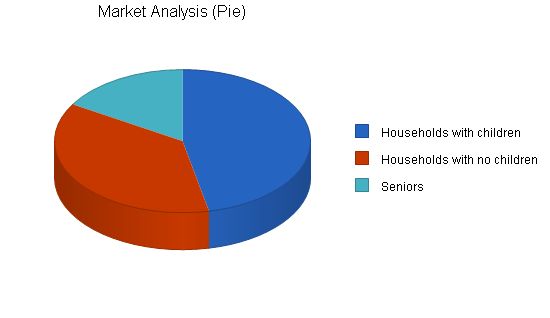
Market Analysis
Year 1 Year 2 Year 3 Year 4 Year 5
Potential Customers Growth CAGR
Households with children 10% 73,864 81,250 89,375 98,312 108,144 10.00%
Households with no children 10% 58,404 64,244 70,668 77,735 85,509 10.00%
Seniors 12% 25,852 28,954 32,428 36,319 40,677 12.00%
Total 10.33% 158,120 174,448 192,471 212,366 234,330 10.33%
4.2 Target Market Segment Strategy
We have chosen target market segments with a greater need for our services. Families with children spend a lot on fast food and junk food due to lack of time to cook healthy meals at home. Busy working couples and individuals without children spend a lot on eating out as they may not have the skills or desire to cook for themselves. Seniors struggle with obtaining and preparing quality ingredients and may prefer alternative food preparation arrangements.
Our marketing strategy for all groups will emphasize our relatively inexpensive, fun, and easy approach to preparing healthy meals. We will vary our serving sizes, menu options, and level of preparation for each group to accommodate most family sizes.
The main objection most potential customers will raise is cost. To address this, we are starting our marketing and sales campaigns with established groups at discounted prices. We anticipate that these positive experiences will generate significant word of mouth and referrals from satisfied customers.
4.3 Service Business Analysis
What’s For Dinner? is unique among Dallas meal preparation options. We have no direct competitors. Personal chefs are available at a very high price, which our target market segments cannot afford. Indirect competitors include area restaurants, but they do not fulfill local residents’ daily meal needs.
Our competitor restaurants compete on price, perceived convenience, and atmosphere. However, they often offer poor quality food and atmosphere. Going out to eat can also be time-consuming. In contrast, What’s For Dinner? provides high-quality meals at lower prices and offers convenience by preparing meals in advance and allowing customers to eat and unwind in their own homes.
4.3.1 Competition and Buying Patterns
We will operate our business as if we are entering an aggressive and hostile market, even though we have no direct competitors. We believe that word-of-mouth and customer retention are significant factors in our success. Our competitive edge lies in providing high-quality meals, relatively low prices, time-saving meal preparation, reducing mess in customers’ kitchens, reducing stress around meal prep, and simplifying the decision-making process.
We will price ourselves at a lower level to attract and retain customers, while maintaining a gross margin of around 25%.
Strategy and Implementation Summary
What’s For Dinner? will gain market share in Plano, Frisco, Allen, and McKinney by leveraging its competitive edges: attention to detail, revolutionary food-servicing outlook, and excellent nutritional meals at competitive prices.
5.1 Competitive Edge
What’s For Dinner? has no direct competitors in the Dallas/Ft. Worth area. By being the first-mover, we will have the initial market buzz reserved for the first company of its kind. Our unique positioning and advantages, such as high-quality meals, relatively low prices, and time-saving meal preparation, will help us grow and outpace potential "copy-cat" businesses. We will continuously enhance our operating procedures and focus on strategy, marketing, business development, quality, and customer service.
5.2 Marketing Strategy
Our initial focus will be to create brand recognition and buzz. We will implement a targeted advertising campaign, offer specials to entice customers, and engage in networking. Our advertising campaign will utilize local area newspapers, newsletters of homeowner associations and churches, direct mail advertisements/flyers, various physical locations for flyers and pamphlets, yellow pages advertisement, a dynamic website, registered keyword searches, radio advertisements, and event sponsorships.
We will also offer periodic specials to limit customer fears and gain their trust. Networking will be a key component of our marketing strategy, starting with the owner’s contacts and friends attending our first months’ meal prep parties. We will incentivize them and other customers to refer new customers.
5.3 Sales Strategy
Our sales strategy will revolve around customer service excellence, good variety of menus, high quality of food and ingredients, creating a fun and social atmosphere, and offering special discounts and incentives to increase customer retention. We will implement a comprehensive and highly interactive e-commerce initiative to accommodate our customers’ payment and scheduling options.
Our website will be a key selling tool, allowing customers to register for meal prep parties and make payments online. We will also engage in follow-up and reminder programs through email and mail to encourage repeat business.
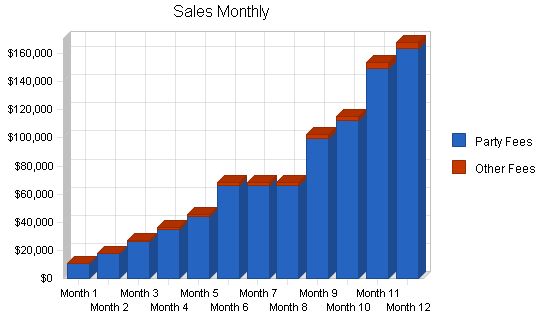
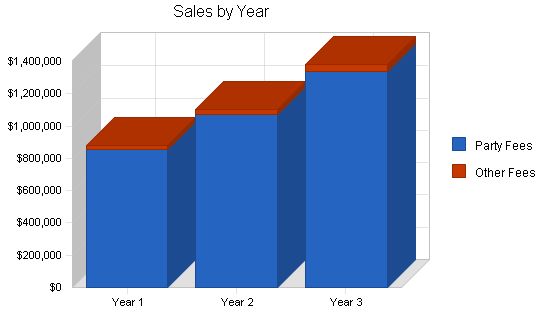
Year 1 Year 2 Year 3
Sales
Party Fees $857,674 $1,072,093 $1,340,116
Other Fees $24,505 $30,631 $38,289
Total Sales $882,179 $1,102,724 $1,378,405
Direct Cost of Sales
Year 1 Year 2 Year 3
Ingredients $612,624 $765,780 $957,225
Other Supplies $44,109 $55,136 $68,920
Subtotal Direct Cost of Sales $656,733 $820,917 $1,026,146
5.4 Milestones
The accompanying table lists program milestones, dates, and budgets. The milestone schedule emphasizes planning for implementation. Our business plan includes provisions for plan vs. actual analysis, and we will follow-up often to discover variances and course corrections.
What’s For Dinner? will have several milestones, including:
1. Business plan completion: This roadmap is an indispensable tool for ongoing performance and improvement.
2. Building set up.
3. Our first meal prep party.
4. Profitability.
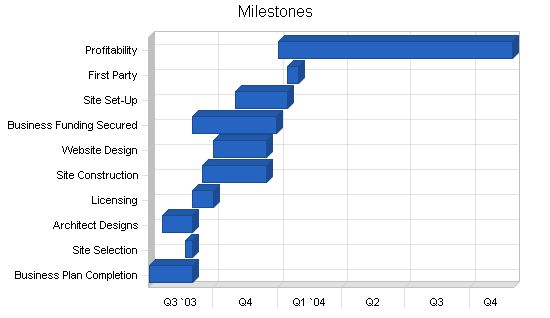
Milestones
| Milestones | |||||
| Milestone | Start Date | End Date | Budget | Manager | Department |
| Business Plan Completion | 7/1/2003 | 9/1/2003 | $250 | Alan Kirby | Administration |
| Site Selection | 8/22/2003 | 9/1/2003 | $0 | Alan Kirby | Administration |
| Architect Designs | 7/20/2003 | 9/1/2003 | $5,000 | Alan Kirby | Administration |
| Licensing | 9/1/2003 | 10/1/2003 | $500 | Alan Kirby | Administration |
| Site Construction | 9/15/2003 | 12/15/2003 | $0 | Alan Kirby | Administration |
| Website Design | 10/1/2003 | 12/15/2003 | $1,280 | Alan Kirby | Web |
| Business Funding Secured | 9/1/2003 | 12/30/2003 | $0 | Alan Kirby | Administration |
| Site Set-Up | 11/1/2003 | 1/15/2004 | $0 | Alan Kirby | Administration |
| First Party | 1/15/2004 | 1/30/2004 | $0 | Alan Kirby | Administration |
| Profitability | 1/1/2004 | 12/1/2004 | $0 | Alan Kirby | Administration |
| Totals | $7,030 | ||||
Web Plan Summary
The What’s For Dinner? website will serve as a virtual business card, party scheduler, and payment acceptance source. It will showcase our services and highlight their benefits. The website will be a crucial portal for scheduling parties and cross-referencing availability with party menus. Customers can also register for parties and make payments using PayPal.
Website Marketing Strategy
The What’s For Dinner? website will be a strategic and crucial part of our marketing mix. It will attract new customers and facilitate scheduling, menu selection, and payments. We will promote our website in all marketing programs, including newspaper ads, yellow page ads, business cards, and flyers. Targeted keyword searches will help potential customers find our website. Our website will also be prominently featured on all napkins, packaging, and receipts to facilitate repeat business.
To encourage website use, we will offer special discounts to customers who register their parties and pay online. Our website will be easy to access, navigate, and provide answers to customer questions. It will also have secure payment methods. We anticipate that younger, internet-savvy customers will be the primary users of our website, while senior customers may prefer phone or direct contacts for scheduling and payments.
Development Requirements
The What’s For Dinner? website will be developed by a local web design artist with experience in e-commerce. They will design a database interface for schedule adjustments, click/sales tracking, and menu updates. A graphic artist will work on the website logo and graphics. Hosting and technical backend support will be subcontracted.
Management Summary
The What’s For Dinner? management team consists of the founders/owners, Alan and Kim Kirby. During the first year, we do not anticipate hiring additional full-time staff as we will outsource services like e-commerce infrastructure, accounting, marketing, and legal services. However, we plan to employ one part-time employee for cleaning and dishwashing.
Alan and Kim have 15 years of experience in the food service and entertainment industries. Kim will continue working part-time as a personal chef in the mornings, while Alan will host most of the parties. In the second and third years, we may hire local high-school students as sous-chefs. Our connections with local social and community groups, food distributors, specialty grocers, and high-end clients will help generate sales.
Throughout the first two years, we will analyze our capabilities as owners and determine what activities require assistance.
Personnel Plan
The following table summarizes personnel expenditures for the first three years. Compensation will increase from $34K in the first year to about $60K in the third year. We believe this plan strikes a fair balance between fairness and efficiency, aligning with our mission statement. The detailed monthly personnel plan for the first year is available in the appendices.
| Personnel Plan | |||
| Year 1 | Year 2 | Year 3 | |
| Alan Kirby | $24,000 | $30,000 | $40,000 |
| Kim Kirby | $5,000 | $7,500 | $10,000 |
| Part-time cleaner | $5,000 | $7,500 | $10,000 |
| Total People | 3 | 3 | 3 |
| Total Payroll | $34,000 | $45,000 | $60,000 |
Hello!
I’m Andrew Brooks, a seasoned finance consultant from the USA and the mind behind phonenumber247.com.
My career is built on a foundation of helping individuals and businesses thrive financially in an ever-changing economic landscape. At phonenumber247.com, my aim is to demystify the complex world of finance, providing clear, actionable advice that can help you navigate your financial journey with confidence. Whether it’s personal finance management, investment strategies, or understanding the nuances of market dynamics, I’m here to share insights and tools that can propel you towards your financial goals.
Welcome to my digital space, where every piece of advice is a step closer to financial clarity and success!
